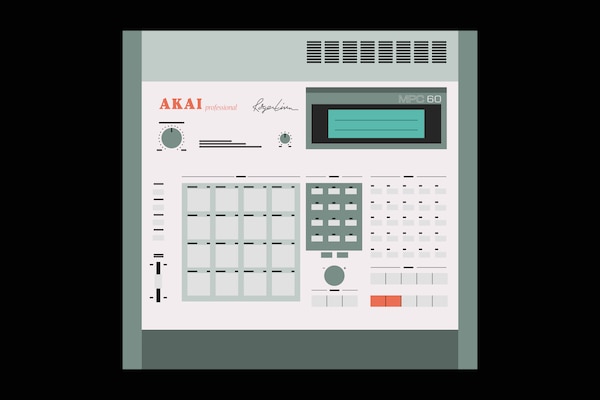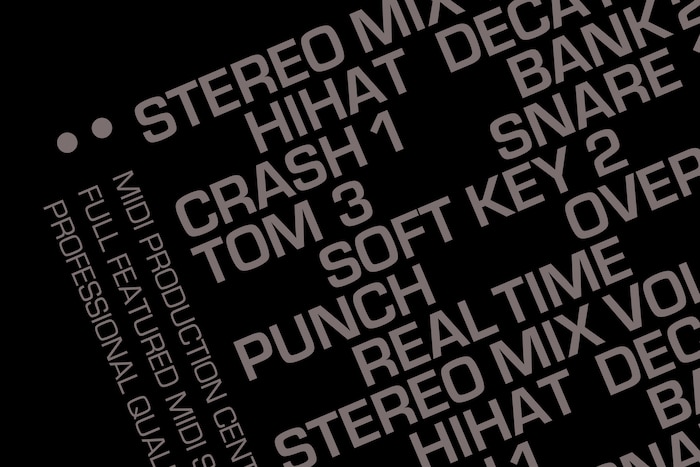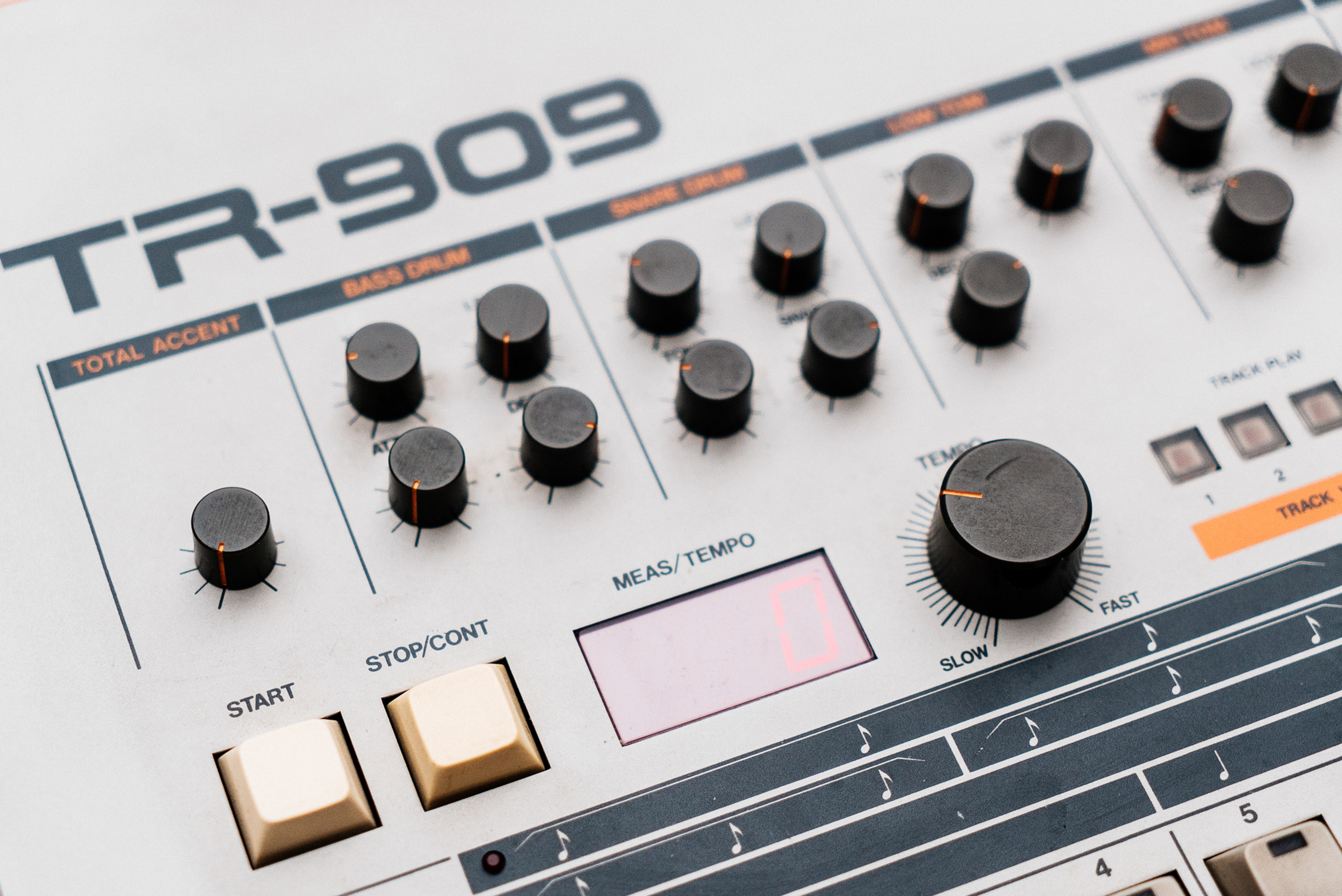Instrumental Instruments: MPC60

Our series on important music-making devices continues with the sampler and sequencer that remains forever associated with hip-hop
Hip-hop as an art form didn’t come out of nowhere, and neither did its elements or its tools. Turntables existed before hip-hop, as did the mixer, the MC and rap itself. Machines that sampled sound also came to life outside of any specific genre, but it was hip-hop producers who would stretch those machines beyond their intended purpose. The MPC60 sampler was one such instrument, revolutionizing the sound of a genre and in the process confounding even its creator with the innovations it put forth.
“It was a phenomenon that we never expected,” says Roger Linn, the California musician and engineer who in the late 1970s designed and developed the LM-1 drum machine, the LinnDrum, and then later the MPC60. “That people would do this, what I call object-oriented composition or OOC, which is where instead of composing and playing all the notes yourself, you play some of the notes, but for other sections you’ll just take a section from a recording where someone had already gone through the trouble of playing those pesky notes.”
When it was released in 1988, the Akai MPC60 filled a void few knew existed.
That wasn’t part of Linn’s original plan, but he also hadn’t set out to make drum machines. In the mid-’70s Linn was playing guitar behind the late rock & roll journeyman Leon Russell, who was using drum machines as metronomes in the studio and then overdubbing drummers. In Los Angeles, where they were working, drum machines were everywhere – appearing in more and more songs on the radio, with session drummers learning how to program and play along with them so they wouldn’t be out of work. But Linn thought the sounds in those early beat machines sounded cheap, and he wasn’t alone.
So he went to work. Almost entirely self-taught and without any formal training in engineering, Linn designed a computerized drum machine where you could plug in sequential values and produce a beat made of sampled acoustic sounds. He built his creation from a computer called the Compal 80, using parts he purchased from Roland, and did all of the programming in Basic.
“It was a time when people were applying microcomputers to a variety of fields,” he says. “And my choice of field to apply computers to was musical instruments.”
Linn didn’t necessarily intend to mass market his invention, but his proximity to the music industry allowed him to get his prototype in front of a lot of interested parties. An early meeting with Stevie Wonder sent Linn scrambling back to the drawing board to make the machine more accessible to the visually impaired, and that was when he began working with sampled sounds. The Linn Electronics LM-1 Drum Computer started shipping in 1980, costing around five grand, and it was a completely new tool. Whereas every other drum machine on the market featured digital sounds, the LM-1 sampled the sounds of real drums, and went a long way towards helping drum machines shed their image as toys. They were finally being taken seriously, and music industry heavies picked up on it. Leon Russell got one of the first ones, as did Herbie Hancock and Captain & Tennille mastermind Daryl Dragon. Peter Gabriel, Madonna and Quincy Jones all got their hands on one, and Prince used it through his entire career. The LM-1 was a hit, and the LinnDrum arrived in 1982, followed two years later by the Linn 9000. Then, Linn Electronics went belly-up. For the first time since he’d started making drum machines, Roger Linn was out of the market he had helped create. But he continued working on his own, and in 1986, while in the process of developing a MIDI drum machine, the Japanese electronics company Akai approached him with the idea of a working partnership. Together they reached an agreement and formed a new company called Akai Professional. Linn was the designer and his team wrote the software, while Akai handled development and production.
“I always designed a product from the outside-in,” says Linn. “I said what every button needs to be… What it does and where it needs to be, what size it is, what the screen should be, and then I drew what every screen should say. I had drawings of what all the inputs and outputs on the back panel should be and where they should be located and all that sort of stuff. Then they said, ‘It would be easier if we had this jack over here or could do this over here.’”


On the MPC60, the user could dictate the space between the sounds and play the sequence by touch.
When it was released in 1988, the Akai MPC60 (MIDI Production Center 60) filled a void few knew existed, satisfying a need within the global community of hip-hop and electronic music producers that had been a long time coming. Linn says there were two kinds of drum machines at that point in the 1980s: “There was mine, the MPC or the ones that were based on the LM-1 and the LinnDrum – which focused on real-time programming – and then there was the Roland’s very creative, very beautiful series of 808-based machines or ones that came off the 808 design. They were based on step time where you had to turn a particular sixteenth note on or off for a particular drum. You know, every machine tends to create its own style of music.”
True to that notion, the primary way the MPC60 changed things was that every producer found their own way of using it.
“The MPC was the first one where you could actually play keyboards,” says Scotty Hard, a New York producer and musician who has worked with artists as diverse as Wu-Tang Clan, De La Soul, and Medeski Martin & Wood. “You could sequence keyboards and other stuff outside of the MPC. It was not just a drum machine, you know, it was really a full-blown sequencer.”
“I started doin’ beats on it and I never turned back to anything else,” says producer N.O. Joe, who has worked with Geto Boys, UGK and Brian McKnight. “I could have, like, four different keyboards that I actually sequenced and quantized within the MPC.”
“The drums, the quality — we could hear it!” says Carlos Garza, AKA DJ Styles, a Houston producer best known for his work with rapper Devin the Dude. “It had a certain sound, a certain bang where 808s, snares, everything just sounded better. The quality of the drums and everything that you would put into it was super amazing.”
There are differing schools of thought on what characterizes the MPC60’s sound, – if there is an MPC “sound” at all – but it would be accurate to say that its louder sampling capabilities combined with the compression and equalization in its method of analog to digital conversion produces a sound that is fatter than any machine that came before it. Its design was also a functional innovation: The MPC60 has a small screen and a simple display that recalls the DOS interface of the earliest computers. There are 16 pads, with 32 different drums in the machine’s memory, and 99 sequences can be programmed into it. A turntable (or often another sampler) is plugged into the MPC and then recorded (sampled) and assigned to one of the keypads, and saved to disk. It has a 12-bit sample rate and can handle 13.1 seconds of sample time, which many producers would maximize by speeding up records to 78 RPM so that they could sample more of it, then slowing it down once it was in the machine. Sounds are loaded through a floppy disk drive, which can take up to a minute to load – an eternity if one is being used onstage.
Like its predecessor the LinnDrum, the MPC also made it possible to do real-time programming, meaning that a beat could actually be played and allowed to shift outside of the metronome. That was different from a drum machine such as the TR-808 or 909, where sixteenth notes of measures were input into slots and automatically locked in. On the MPC60, the user could dictate the space between the sounds and play the sequence by touch. The machine’s rubber pads gave it an elasticity accommodating the user’s finger movements, and the acoustic drum sounds gave it a more realistic feel. Still, others might have been looking for the MPC to square up the rhythms in their drumming, a problem that Linn’s design inadvertently solved.
“I created this real-time recording routing that would record in a loop, play in a loop a metronome and then you’d press the buttons in time with the metronome and it would play,” Linn says. “Well, the funny thing about it is since I was storing everything only in the closest sixteenth note memory slot, when it played back everything had my timing errors corrected. So I decided that this was not a bug but rather a feature.”

Producers with a musical touch could bring their own swing to the pads, dictating the variations in rhythm.
That timing correction became known as quantizing, and is now the feature of every drum machine as a default. But the MPC60 also offered a way around that for a producer trying to get closer to the feel of a real drummer without programming in real time. The thing no machine can reproduce is what makes all drummers different — their rushes and pauses, the intangible things that can’t be measured. Every drummer has a different swing, a hesitation or emphasis on certain parts of the beat. Drum machines had always been segmented off into sixteenth notes, which was what a lot of producers wanted. But drummers don’t repeat their emphasis or their lag time with every beat – that moves within the song.
“A lot of times you might wanna have the kick and the snare landing pretty much right on the one and two,” says Scotty Hard. “But the hi-hats were something that you would wanna kinda swing. And you were able to do that with the MPC, which was one of the coolest things about it.”
That meant that a loop could be made to sound less than perfect, which is exactly what makes a song swing. Humans are not perfect in their movements when they dance, and drummers are not perfect in their time when they play: The human element is what makes other humans dance. The MPC60’s finger pads allowed for someone with a feel for rhythm to play a beat rather than plot it out. That was how producers with a musical touch could bring their own swing to the pads, dictating the variations in rhythm.
That’s one interpretation of how something can swing through the MPC, but hip-hop producer Dan the Automator has a different take. “We make it swing by leaving air in front of and in back of a hit to make it hit later or earlier, so it wasn’t even from the sequencer, you know? Realistically, when people talk about hip-hop and they talk about swing, the greatest swing in the world is DJ Premier, basically, for the boom-bap, and that’s all just because of his brains and his hands.”
Boom-bap is the production style for which Premier, a Texas native who made up half of the NYC hip-hop duo Gang Starr, is known. The MPC60 has been a weapon of choice for him since the earliest part of his career, and its sequencing capabilities allow for the chopping back and forth within drum loops and samples that give boom-bap its unique feel. His style became as influential in the late ’80s and early ’90s as the West Coast G-funk of Dr. Dre — another famed user of the MPC series — and his style has endured. The MPC is also a favorite of New York producer Prince Paul, MC Dalek, Jermaine Dupri and French electronic legend Jean-Michel Jarre. DJ Shadow’s landmark 1996 album Entroducing....., which had engineering help from Dan the Automator, was the first album ever produced entirely from samples, and it was produced entirely on the MPC60.
Having delivered as close a direct answer to the genre’s needs as anything that had been developed at its time, the MPC60 remains forever associated with hip-hop. Roger Linn is still working to this day, in the studio built into his house. He has his ear on what’s going on in the world in music and technology, and sees one problem to which his own creations may have contributed — the loss of the solo. It’s an issue he’s trying to remedy. He developed a line of guitar processors called AdrenaLinn back in 2000, and more recently the LinnStrument, a MIDI-controlled synthesizer that reads the subtle movements of the fingers and allows a musician to move seamlessly between a larger scope of notes, and thus express themselves via the solo. It would be a new revolution for the inventor whose line of electronic instruments made it possible for so many to reimagine sound — to come back full circle to the organic, physical motions of music-making. Technology has afforded today’s producers with limitless capabilities, but the generations who grew up seeing the MPC60 break through a wall and open up the possibilities of sound remember vividly how different things were after its release.
“We are now able to have all the sample time we want,” says Dan the Automator. “So we treat things a little differently than we would have back then, and the MPC at that moment had as much sample time as we could get in the drum machine.”
“I remember when I bought the MPC,” says Scotty Hard, of one he recently purchased for his studio. “A friend of mine said, ‘What are you doin’, man? I gave mine up years ago.’ But I use Pro Tools, and I’m in front of a computer enough. I just wanna go back to something more tactile. I mean, I’m a musician first, so hitting things and plucking things and having a physical relationship with something as an instrument was always just a little sexier.”
Header image © Akai™ / RBMA
